1977 $20 Dollar Bill Value: How Much Is It Worth Today?
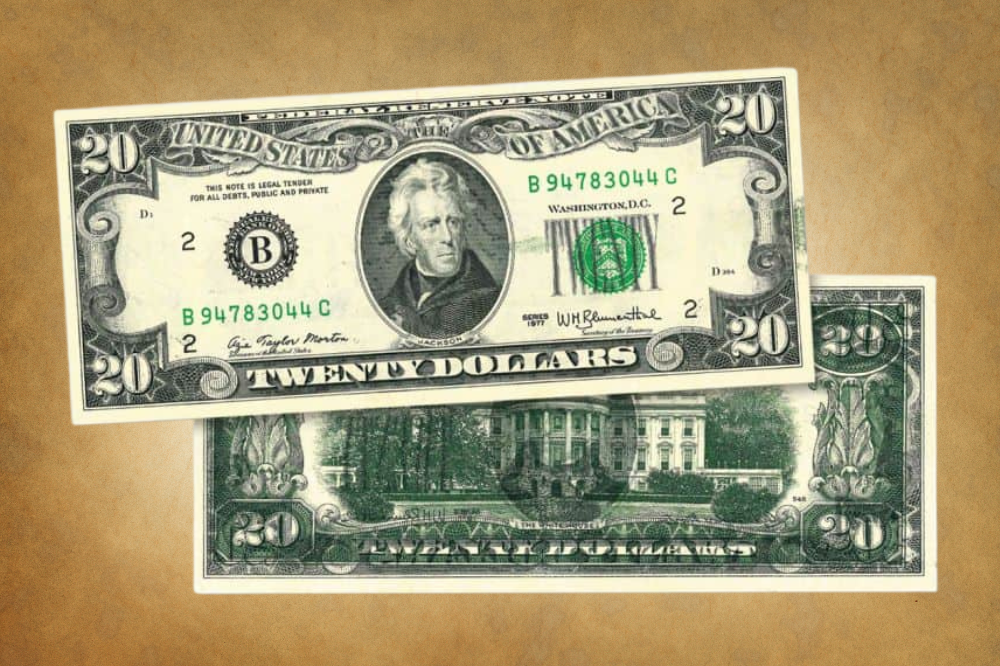
In 1976, the US Mint released a Bicentennial Set of three coins – a Quarter, a Half Dollar, and $1. This got more people interested in numismatics (the study, trade, and collection of coins, tokens, medals, and paper money). The next year, this newly revamped hobby kept gaining steam among coins and bank notes. So let’s look into the 1977 20 Dollar Bill Value.
1977 20 Dollar Bill Price Tables
Several factors can raise the resale price of a 1977 $20 Bill. These include errors, fancy serial numbers, Federal Reserve Bank Districts, and star notes. In upcoming sections of this article, we’ll look at these criteria in detail. But for now, let’s explore the prices of some $20 Bills from the 1977 Series. We’re including the sale date to ensure transparency and verification.
1977 20 Dollar Bill Value Chart |
||||
$20 Bill Series |
District/Branch |
Date of Sale |
Grade |
Price |
| Fr. 2072-A 1977 $20
Solid #5s Serial Number |
Boston | 24th March 2012 | 63 PPQ Choice Uncirculated | $1,495 |
| Fr. 2072-D 1977 $20 Solid #1s Serial Number | Cleveland | 25th August 2023 | 65 PPQ Gem Uncirculated | $1,800 |
| Fr. 2072-E* 1977 $20
Star Note |
Richmond | 12th January 2022 | 65 EPQ Gem Uncirculated | $100 |
| Fr. 2072-L 1977 $20
Low Serial Number #8 |
San Francisco | 1st December 2021 | 64 PPQ Choice Uncirculated | $528 |
1977 20 Dollar Bill Value Guides
Let’s talk about the letters and numbers on the 1977 $20 Bill because they do affect its value. On the upper left and lower right, you’ll find the face plate number and position. The letter is the same but the number sometimes differs. And if the note was printed in Fort Worth, the lower face plate number will have FW to differentiate it from notes made in Washington DC.
The number that appears four times is the District Number. It corresponds with the letter in the District Seal since these branches all have a letter from A to H and a number from 1 to 12. This directly influences the value of a 1977 $20 Bill because some districts attract attention and therefore higher prices. Next come the serial numbers on the upper right and lower left.
Serial Numbers on 1977 $20 Bills
If they aren’t identical, that raises their resale price. Lower figures (below 100) and higher ones (that start with 9) are especially expensive. You can also check for fancy serial numbers e.g. ladders like #23456789, repeating numbers like #45454545, mirrors like #14633641, and book ends like #50000005. Star notes have a star suffix to mark them as replacements.
This means a note got damaged in the press so they destroyed it and made a new note that had the same serial number, replacing the last letter with a star. They’re generally more expensive than regular bank notes. But some $20 Bills do escape the BEP with mint mistakes and we’ll review them in the Errors Section. For now, let’s look at some top 1977 $20 Values.
1977 $20 Bill Value
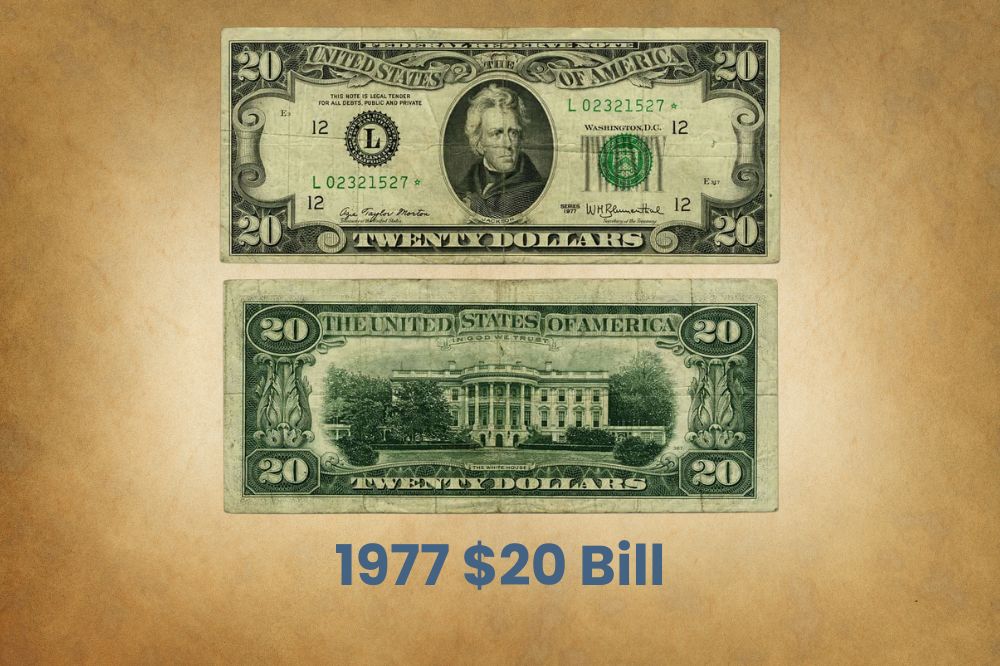
The 1977 $20 Bill was signed by Treasury Secretary Werner Michael Blumenthal and US Treasurer Azie Taylor Morton. On 25th August 2023, a Fr. 2072-D 1977 $20 Bill sold for $1,800. It was graded Gem Uncirculated 65 PPQ and had a Solid #1s Serial Number. A decade earlier, an Fr. 2072-A Choice Unc. 63 with Solid #5s sold for $1,495 in March 2012.
In the Errors Section, we’ll discuss the following example in detail. But just to show you the price differences caused by districts and sales dates, we’ll compare four Offset Errors. A face-to-back 2072-G (Chicago) graded 63 EPQ Choice Unc. was $432 in August 2021. The next three were 64 EPQ Choice Unc. The 2072-B face-to-back note was $408 in March 2023.
But the 64 PPQ 2072-L (San Francisco) back-to-face note was $216 in January 2023. And the 64 EPQ 2072-K (Dallas) face-to-back was $312 in March 2021. As for star notes, a 65 EPQ Gem Uncirculated 2072-E* (Richmond) sold for $100 in January 2022. But one month earlier, a Low Serial Number #8 2072-L (San Francisco) sold for $528 in December 2021.
1977 20 Dollar Bill Grading
Paper Money is graded by various companies including PCGS (Professional Coin Grading Service), PMG (Paper Money Guaranty), RQN (Review Quality Notes), or Banknote World’s TAP. But the best-known grades are based on the Sheldon Scale from Poor to Superb Gem Uncirculated. You’ll also see EPQ or PPQ to describe Exceptional/Premium Paper Quality.
1977 20 Dollar Bill Errors
The designs on older bank notes were printed in three swipes or prints. First was the back, second was the front, and third was the overprint for the seals and serial numbers. But newer notes start with the offset that does the front and back simultaneously, followed by intaglio plate prints for fine details like signatures. Next comes the front or face, and finally the seals.
In both cases, printing errors at the mint can increase the value of a bank note. On the 1977 $20 Bill, examples include missing prints, offsets, foldovers, misalignment flaws, insufficient inking, back-to-face, and face-to-back. Let’s look at some of these 1977 20 Dollar Bill Errors and their prices from verified sales. Some are as recent as last week while others are older.
Fr. 2072-L 1977 $20 Bill Pre-Face Foldover Error
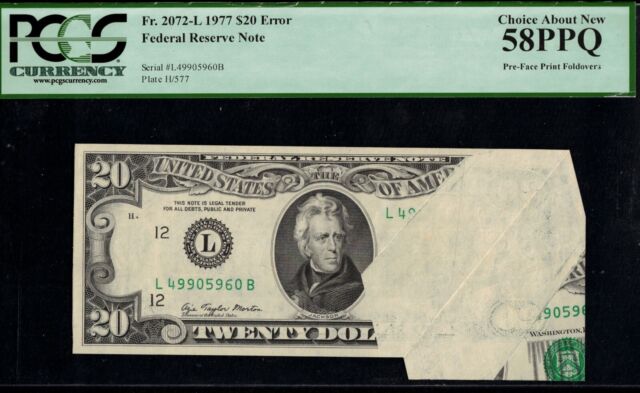
The printing paper can fold at various stages of the process. This affects both the resulting design and the resale price. Here, the front folded before printing, which is sometimes called a butterfly fold. When you unfurl the front, you see some blank spots. But if you fold it up, it looks normal. Graded Choice AU 58, this San Francisco note sold for $1,320 in August 2023.
Fr. 2072-C 1977 $20 Bill Printed Foldover Error
The difference between a butterfly foldover and a printed foldover is the ink. Butterfly folds are hidden from the ink so they end up blank. But printed foldovers end up with ink on the wrong spot. On this note, the Treasury Seal and part of the serial number landed upside down on the back fold. A 64 PPQ Choice Uncirculated was $432 in 2023 and $480 in 2022.
Fr. 2072-G 1977 $20 Bill Printed Foldover Error
This is the same error as above but in a different position and district. On the previous note, the upper right folded, pushing the Treasury Seal to the reverse of the note. Here, the lower left folded, forcing most of the District Seal and serial number onto the lower back of this Chicago $20 Bill. Graded 65 EPQ Gem Uncirculated, the note sold for $423 on 3rd May 2017.
Fr. 2072-D 1977 $20 Bill Printed Foldover and Missing Partial Overprint
When a note has multiple mistakes, its cumulative value rises. This note has quite a low grade – EF 40. But it folded in mid-print, causing the District Seal to miss its location and the upper right serial number to partially graze the back of the note (because the front fold obstructed it). So it only has one serial number. It sold for $1,116.25 on 10th August 2012.
Fr. 2072-E 1977 $20 Bill Overprint on Back
In the examples above, the foldover pushed part of the seals and/or serial numbers to the back. But in this case, the entire note flipped after the front swipe. That means both seals and both serial numbers ended up on the back of the note while the front had no color. Graded 65 EPQ Gem Uncirculated, this 1977 $20 overprint mistake sold for $360 on 18th April 2018.
Fr. 2072-B 1977 $20 Bill Full Offset Face-to-Back
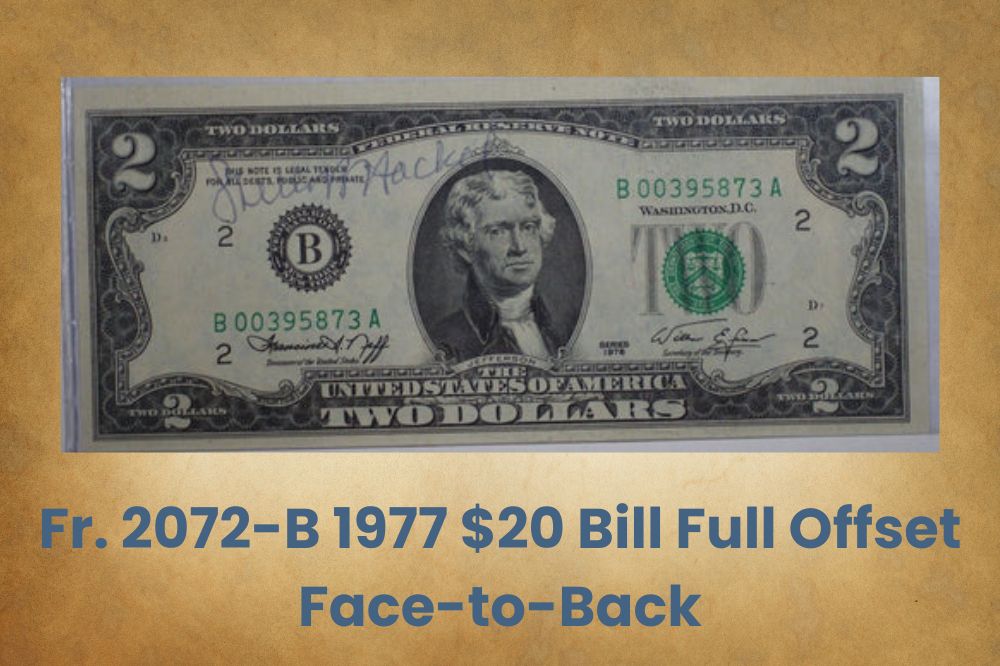
On coins, when the dies hit each other without a blank between them, it causes a die clash. On notes, that’s an offset, because the inked impression cylinder swipes an empty plate with no paper on it. The cylinder then picks some of the design details so that when it presses the next note, the front details overlay the back design or vice versa. In Choice Unc. 64, it was $408.
Fr. 2072-L 1977 $20 Bill Mismatched Serial Number
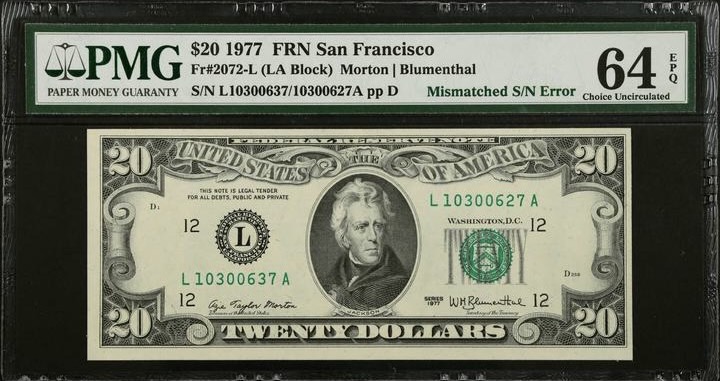
Whenever you get paper money, carefully compare the two serial numbers. They might have a gas pump error where one of the digits is higher or lower than the rest. Or sometimes, their digits (i.e. the numbers) and suffixes (i.e. the letters or stars) aren’t identical. Here, the top has #627 and the bottom has #637. In 64 EPQ Choice Unc. it sold for $780 in August 2023.
Fr. 2072-B 1977 $20 Bill Missing Back Error
Missing print errors look quite dramatic, but they’re not always expensive. They happen when two sheets get stuck together so the inked impression cylinder only prints one. Think of it as a die cap error for bank notes. Here, the front is normal but the back is blank. It was graded 63 Choice Unc. which is reasonably high. But it only sold for $288 on 18th April 2018.
Fr. 2072-J 1977 $20 Bill Retained Obstruction
Just like coins, foreign objects sometimes slip between the printing plate or the impression cylinder and the paper. And if the contaminant stays on the note after completion, it’s worth a lot more. A piece of another $20 bill got stuck on this one, leaving part of the back blank. The two pieces sold as a unit for $2,937.50 in August 2012. They were graded 63 Choice Unc.
Fr. 2072-B 1977 $20 Bill Double Print Error
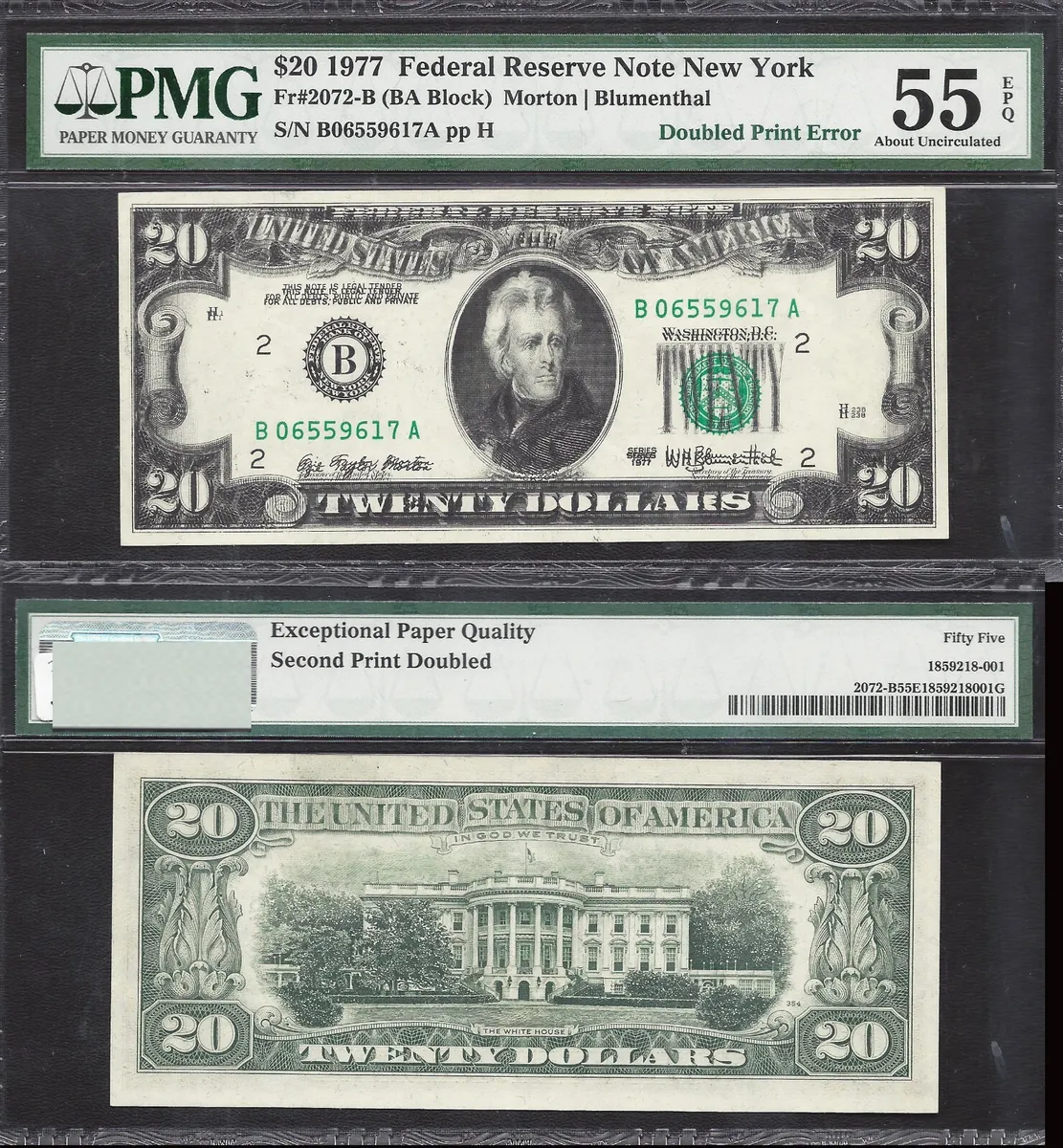
While double strikes are common on coins, they’re rare on bank notes because each print has one swipe. But in this case, the second print was doubled so the whole of the obverse has that blurry double-vision effect, including the signatures and legal tender statement. Because it’s such a rare and dramatic error, it was $1,860 in November 2017, even in a low-grade EF 45.
History of the 1977 20 Dollar Bill
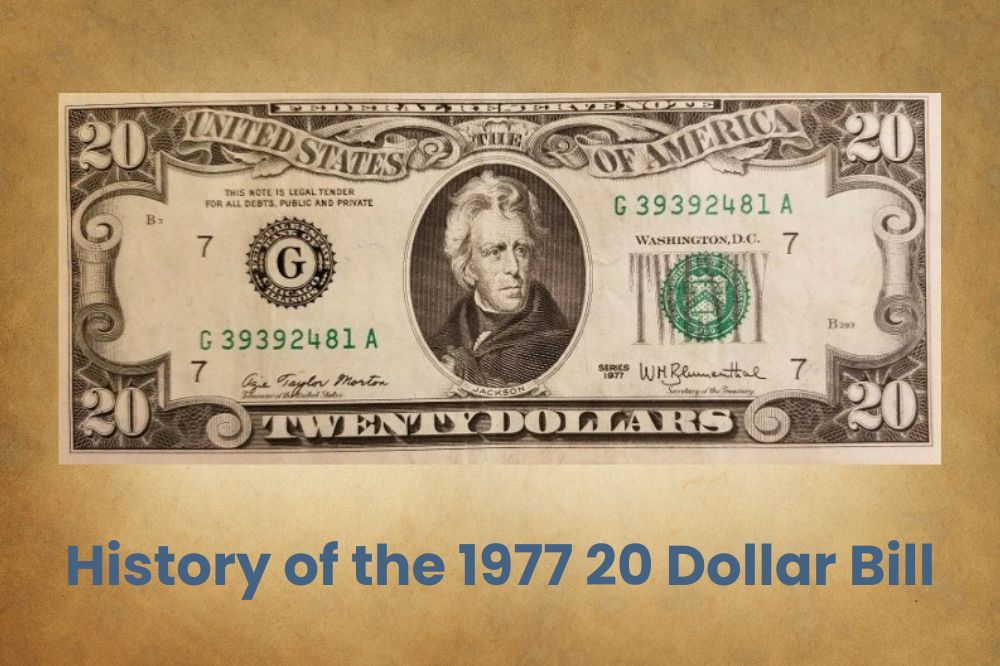
As we mentioned earlier, the Bicentennial drew lots of fresh eyes to coin collection, and bank notes benefited from this influx. For reference, the bicentennial was celebrated the 200 years since we gained independence from the British. So while coins usually have one date, these bicentennial coins had two – 1776 to 1976. But the dates on bank notes are a little different.
On coins, the date tells you when the coin was minted, with a few exceptions such as the 1964 pennies. But with bank notes, the series date tells you when the design was initially approved so the same date can be used for several years. Other denominations were facing changes in 1977 too. For example, $1 Bills printed in Richmond were experimenting with Natick Paper.
Meanwhile, the BEP (Bureau of Engraving and Printing) introduced a serial number press. It was used on some $20 Bills and you can spot them by their slightly different font. The older press was slowly phased out and was fully retired in 1981. Other than that, the 1977 $20 Bill had most of its original design elements, including the south-facing view of the White House.
How to Identify 1977 20 Dollar Bill?
In describing the features of a bank note, you may come across certain technical terms. The front or heads side is called the obverse and the back is the reverse. The words on the note are called legends or mottos, the pictures are called devices, and the background is known as the field. The Friedberg Number for 1977 $20 Bills is Fr. 2072 with a Federal District suffix.
It comes from Robert Friedberg, who wrote a book called Paper Money of the United States in 1953. It has a comprehensive list of circulating bank notes and assigns a Fr. Number to identify each note. This allows numismatists to learn lots of information about the note at a glance e.g. Federal Reserve Bank District, series year, whether it’s a replacement note, etc.
The Obverse of the 1977 20 Dollar Bill
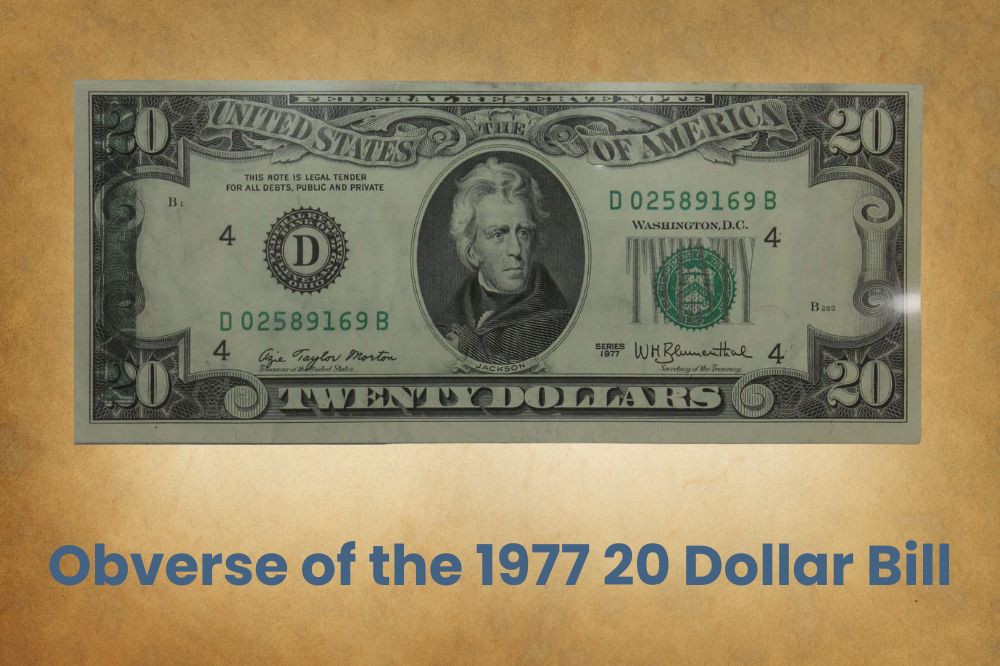
It features Andrew Jackson with his name under his portrait for anyone who doesn’t know him. The top of the note says Federal Reserve Note followed by The United States of America though the words are in the wrong order, with ‘the’ in the middle. The bottom of the note has Twenty Dollars, with the US Treasurer’s signature above Twenty on the left of the president.
On top of that is a serial number, District Seal, and legal tender statement. On the right of the device, the series date and the Secretary’s signature are above Dollars. Above that, the Treasury Seal overlays Twenty with Washington DC and the serial number above the seal. The district letter is inside the District Seal. Its number appears four times. The face plate appears twice.
The Reverse of the 1977 20 Dollar Bill
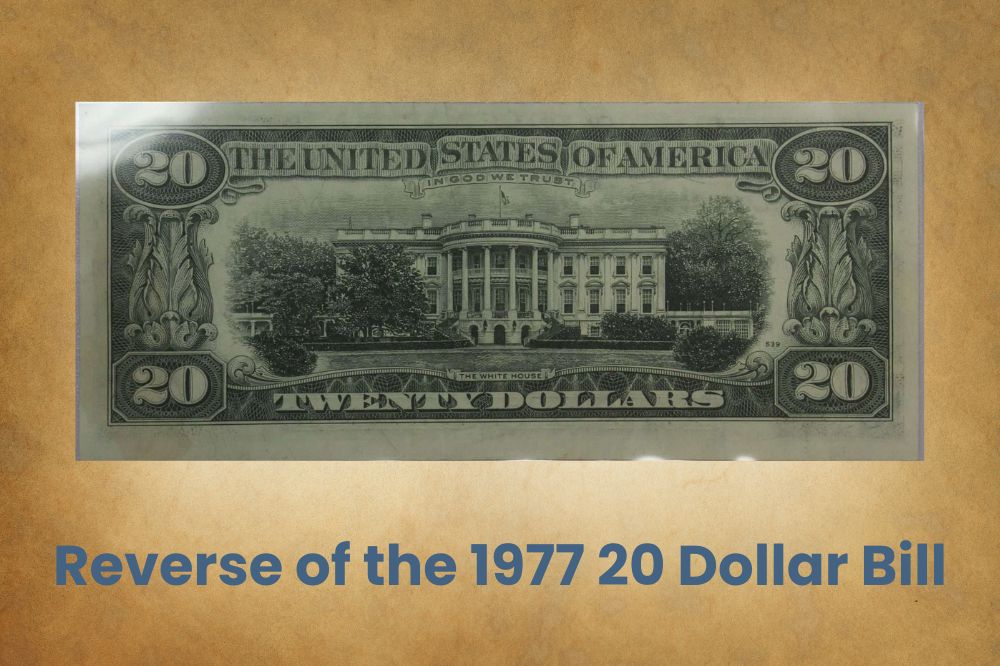
It shows the southern view of the White House. The top of the note says The United States of America followed by the motto In God We Trust. The bottom of the $20 Bill says The White House, with Twenty Dollars beneath the words. The four outer corners have 20 in numerals while the inner bottom right has the back plate number. The sides have decorative abstracts.
Other Features of the 1977 20 Dollar Bill
The 1997 $20 Bill is the same size as all other small-size bank notes introduced in 1928 i.e. 156mm by 66.3mm or 6.14” by 2.61”. It weighs roughly 1g and is made of 75% linen blended with 25% cotton. Plastic security ribbons are embedded inside the note. Bank bundles of $20 Bills are wrapped with violet straps. The $20 Bill is the most widely circulated US bank note.
1977 20 Dollar Bill FAQ
How Much is a $20 Bill from 1977 Worth?
Intact 1977 $20 Bills aren’t especially expensive. But fancy serial numbers can raise prices. A Solid 1s Serial number can get you $2,000 depending on the district. A star note can go as low as $100. However, error notes can cost over $1,000 based on verified sales from August 2023.
